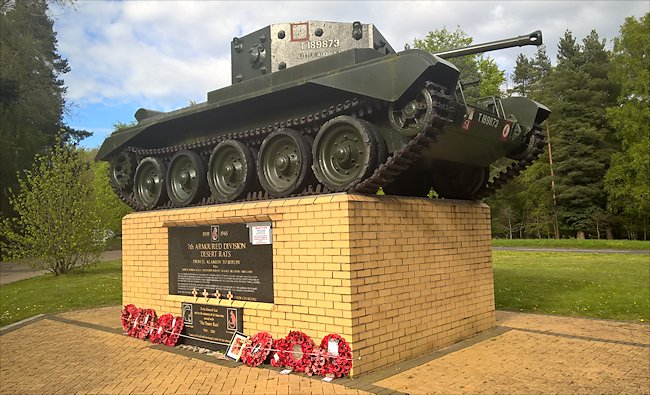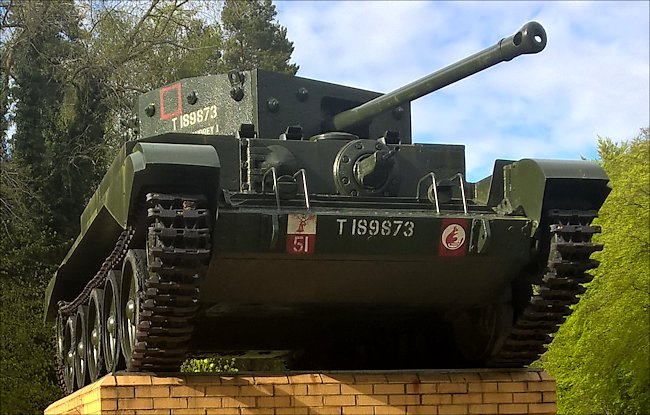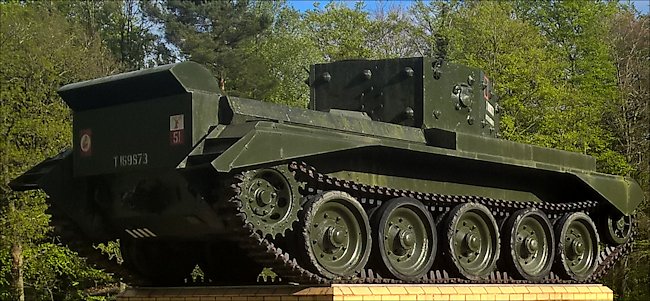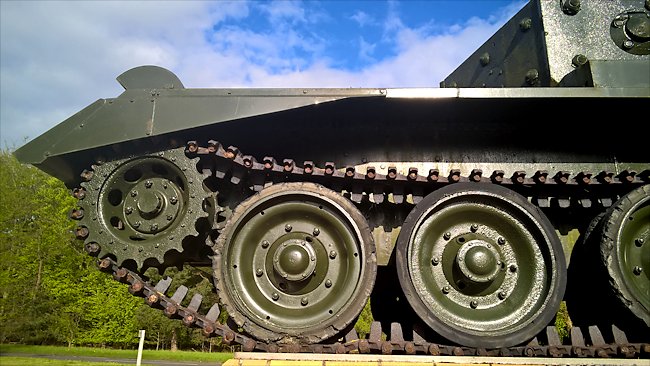Cromwell Tank Mk IV
This Cromwell was restored by R. H. Barrell engineering Ltd. to represent Cromwell Mk IV T189873 Little Audrey II which served in B Sqdn, 1st Battalion Royal Tank Regiment in the Thetford Forest, Norfolk England. It took part of the invasion of Normandy in June 1944. The man behind the idea of this memorial, Mr. Les Dinning served as gunner in this tank. It is along the side of the A1065 one mile north of the village of Ickburgh in Norfolk, England.

Restored Cromwell Tank in the Thetford Forest, Norfolk
At each regimental location, the tanks were positioned in tank parks. The Cromwell tanks had been made in the factories of the Birmingham Railway Carriage and Wagon Company and then by Leyland and fitted with Rolls Royce Meteor engines which were actually modified Merlin Spitfire engines. Delivery to this camp began on 1st February 1944 and so The Desert Rats was the first service unit to take Cromwell tanks into action, on Gold Beach, Normandy, on D-Day, 6th June, 1944.
Lieutenant John Lawson RTR recalled, 'Learning to drive them took time for we over-estimated the number of revs needed to deal with the inertia of 27 tons moving off. We had trouble with clutch plates until the Rolls engineers told us that 600 bhp provided plenty of power at idling revs. All we had to do was to let out the clutch then 'give it the gun' and roar away. The tank sailed across country with a gentle motion and motored along the roads like a private car.

Restored Cromwell Tank in the Thetford Forest, Norfolk
Trooper L J Dinning was convinced that the acceleration and exceptional speed of the Cromwell saved him and his fellow crew members during enemy attacks and he cannot remember a single mechanical breakdown due to engine failure.
All the tanks in the Division were given names and Les Dinning's tank bore the inscription 'Little Audrey Laughed and Laughed'. Although theis Cromwell tank was hit several times by anti-tank weapons, it survived the war. In a German Panzerfaust Bazooka attack on the 26th September, 1944, the tank commander, Sergeant A Davies, and the wireless operator, Corporal A Glenton, were killed.

Restored Cromwell Tank in the Thetford Forest, Norfolk
Every combat, service and support unit in the army has its own detachment of The Royal Electrical and Mechanical Engineers. They are responsible for inspecting, recovering and repairing its vehicles, weapons and machinery.
Lieutenant John Lawson RTR recalled, 'Preparations for water-proofing the Cromwell Tanks for D-Day Landings began. We had to clean every joint in the armour, virtually scouring all the paint from the steel before wiping down with Bostic cleaner Then the joints were sealed with Bostic, squeezed from the tube in long snakes. A large steel trunk was Fitted at the back of the tank to allow the engine exhausts to vent free. The turret was fixed and it was ready to make its way into six feet of water.'

Restored Cromwell Tank in the Thetford Forest, Norfolk
El Alamein to Berlin - The Desert Rats Memorial
The memorial is a tribute to the 7th Armoured Division, better known as the Desert Rats, who were based In the Thetford Forest, just north of the village of Ickburgh in Norfolk, England as they prepared for the invasion of France and D-day.
The Desert Rats were only in the England for five months during the Division's entire existence. Most of the time was spent at High Ash Camp, in the Thetford Forest. The camp was a hive of activity being similar in size to a small town with a cinema, cookhouses, NAAFI, workshops and huts to house all the men. The Cromwell Tank Memorial stands at the entrance to what was once a busy WW2 army camp.
The British Forestry Commission that look after this site has waymarked a walk that will lead you round the forest showing the positions of some of the features that remain of the old camp.
Daily Desert Rat Camp Routine
Transcript from the War Diary of Trooper L J Dinning.
6 am - Wash and shave using a line of cold water taps over a tin
trough covered by a corrugated iron roof. Return to hut and
dress, fold bedding, clean equipment and hut ready for first
parade, after which soldiers go to the cookhouse. Those who were ill would attend
'Sick Parade' outside toe Medical Hut.
7am to 8am - Collect breakfast of porridge, then bacon or sausages and fried egg, or scrambled eggs and baked beans, followed by toast, jam or marmalade and tea from the cookhouse. Carry breakfast to Mess Hut close by, furnished with trestle tables and benches.
8am - First Parade: Squadron roll call and inspection in the Tank Park. Duties allocated, including maintenance, gunnery, wireless training and the collection of vehicles and tanks from depots, depending on specialisation. Some days of field training with mock battles with the troops living on rations and route marches often miles or more, carrying full kit.
Noon to 2pm - March to Cookhouse, collect main meal and eat in Mess Hut. Main course of meat and two vegetables, then one of the following: rice, tapioca, baked pudding, steamed pudding.
2pm to 5pm - Continuation of duties or football, rugby or cricket.
5pm - Off duty except for Guard Duty which was done on a 2 hour rotation throughout the night. Tea of bread and jam but sometimes baked beans or scrambled eggs on toast.
6pm to 11.59pm - Prepare uniforms and kit for next day. Spend time in NAAFI or playing cards in individual huts.
The Cromell tank's faults
The tiger tank devastating Villers-Bocage ambush due to the lack of reconnaissance was certainly a shock. But the most unsettling aspect of the battle was the inability of the Cromwell tank to knock out a Tiger tank, even at point-blank range.
There had been mutterings about the uselessness of British tanks before the invasion. Colonel Lord Cranley had felt obliged to address the tank crews of the Sharpshooters on the subject. He was quite aware of the faults in the tanks, but 'it was no good grousing as we would get no others so we must make the best of things'.
The Cromwell was fast going forwards and had a low profile, but with its flat front it was vulnerable and it had an ineffective gun. Patton was dismissive of both the Churchill and the Cromwell, and even British generals were well aware of the Cromwell's 'design fault'.
Montgomery, in a letter to de Guingand on 12 June, hoped to stamp immediately on any idea of tank inferiority, however true. He did not want his armoured troops to develop 'a Tiger and Panther complex'.
And yet Montgomery himself had criticized British tank design the previous August, when he said, 'We are outshot by the German tanks.' But to try to suppress the problem nearly a year later was flying in the face of reality. The German 88 mm gun, both on the Tiger and the flak gun in a ground role, could pick off Allied tanks before they were able to get within range.
The diary of a British officer in Hinde's brigade was found in a shot-up tank near Tracy-Bocage. The penultimate entry on Sunday, 11 June, read, 'The squadron left to try to take a position and had to return rapidly having lost four tanks. After four years of preparation for the invasion why are our machines inferior?'
WW2 Cromwell Tank books

